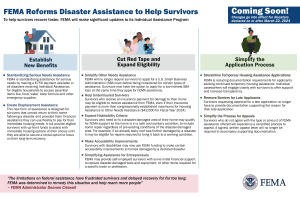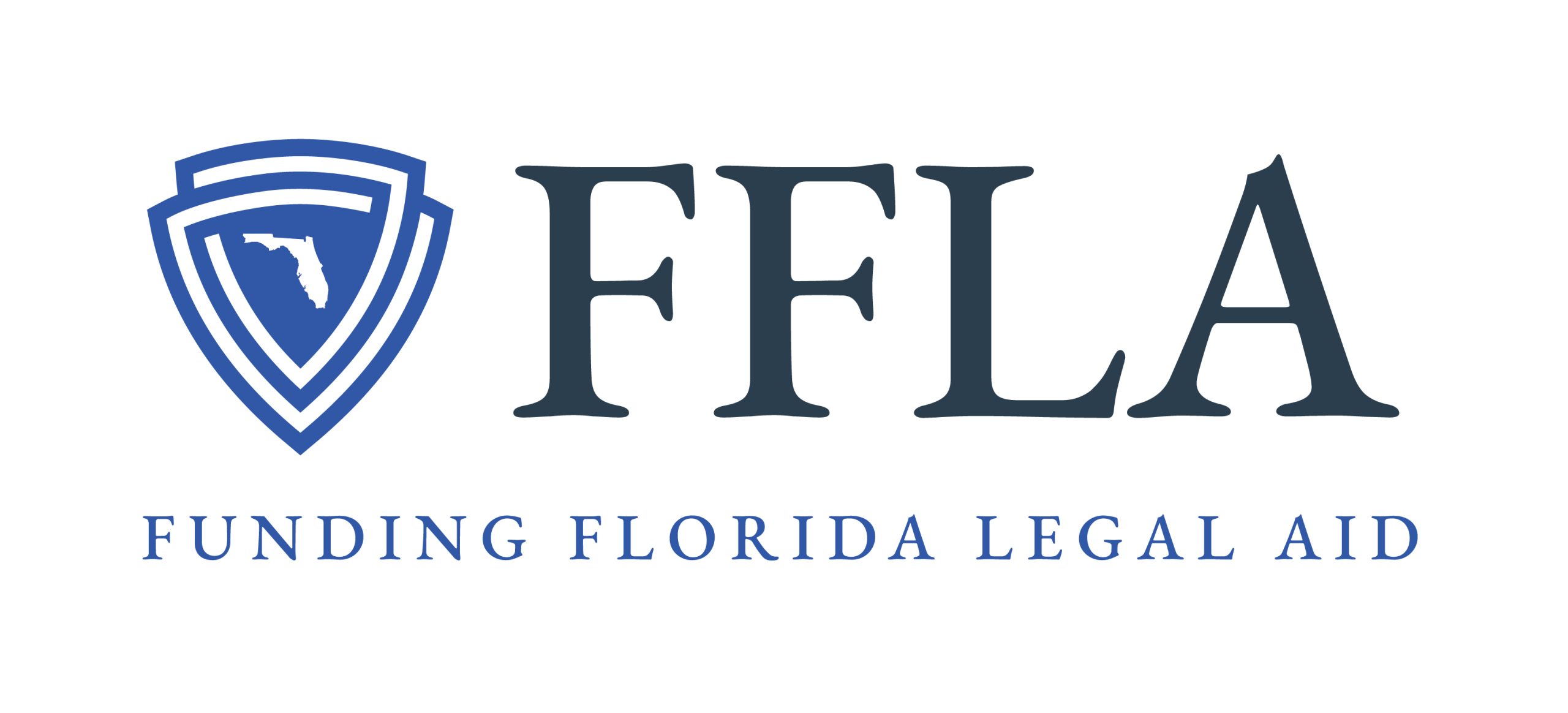FEMA Claims and Appeals
The Federal Emergency Management Agency (“FEMA”) is a government-funded agency that provides public assistance to help communities respond to and recover from disasters. Assistance from FEMA may come in many different forms, such as temporary housing and rental assistance, emergency home repairs, money for personal property losses, payment for flood damage to vehicles that are covered by the minimum insurance requirements, and medical, dental, and funeral expenses caused by the natural disaster.
WHAT ARE YOUR RIGHTS?
When a federal disaster is declared and FEMA services are made available, you may file a FEMA claim to receive assistance with property damage within 30 days of the disaster declaration. In order to gain FEMA assistance, you must demonstrate the damage is in a designated disaster area; you have legal responsibility to perform the work; and the cost of the work is reasonable. Throughout the claim process, FEMA reviews your eligibility, the damage done to your property, the necessary repair work, and estimated costs. After they review and approve your request, you will work with a FEMA representative to develop a damage inventory.
For more information, visit the Consumer Finance government page about disaster preparation.
You cannot receive more than $36,000 in financial assistance from FEMA for each program. If you receive a claim payout from FEMA, you must keep records to show that you used these funds for the damages that are spelled out in your FEMA claim. Failure to use FEMA assistance funds for the losses stated in your claim may force you to repay the funds back to FEMA.
WHAT DO YOU NEED TO DO?
Go to www.DisasterAssistance.gov to start your FEMA application. You may be required to prove your identity with proper identification and proof of ownership and occupancy of your primary residence. Gather all evidence to support your damage claim, such as pictures of the damaged property, receipts for work you have done on your home, and detailed contractor or private adjuster estimates.
Your FEMA claim begins with your initial registration online, by phone, or in person at a FEMA Disaster Recovery Center. To apply for FEMA assistance by phone, call 1-800-621-FEMA (1-800-621-3362). If you want to apply in-person at a Disaster Recovery Center (DRC), you can find a local office near you by visiting this website: https://egateway.fema.gov/ESF6/DRCLocator
Once you file a claim, FEMA will assign you an adjuster to inspect damages to your property. The adjuster will contact you to schedule an inspection of your damaged property. This may take some time due to the number of claims that FEMA receives following a natural disaster.
When the FEMA inspector arrives at your property, be sure to verify the inspector’s FEMA identification badge. It should include a photo and their role as an official FEMA Contractor. If the inspector does not show you photo identification, then do not proceed with the inspection.
While the FEMA inspector is visiting your property, ask property-specific questions about your damage and point out important areas to make sure the inspector does not overlook anything.. Be sure that the FEMA inspector views and considers all the damage during the visit at your property.
FEMA inspectors are usually independent contractors that do not work directly for FEMA. As a result, they will not be able to answer questions about your claim or provide information about when you may receive a decision for your claim. Also, the inspector does not decide whether or not you are eligible and cannot give you details about your eligibility.
After the inspection is completed, the FEMA adjuster/inspector will submit their findings and up to 5 pictures of the home to document their report. Based on this information,FEMA will send you a letter of determination to inform you of its decision to approve or deny your claim.
It generally takes up to 10 days after the inspector leaves for a decision to be made and a letter mailed to the address that you provide, which may be different than the damaged address if you had to move. If they decide that you are eligible for assistance, your payment will be sent to you as a check or an electronic transfer. FEMA will also mail a follow-up letter explaining the ways your are allowed to spend the money.
FEMA offers grants for rental assistance to eligible renters. These grants help pay for temporary housing while a damaged home or apartment is being repaired. Save all your receipts for temporary housing and moving costs because FEMA will require these in order to provide continued assistance. You must save all temporary housing/lease receipts and payments agreements to present them to FEMA is they request you to do so.
If your home is not in a livable condition, you may receive money from FEMA to pay for essential repairs, but you may not receive enough funds to fully cover the costs of repairs to your damaged home or to replace all of your personal property. If you find yourself in this situation, you may apply for a Small Business Administration (“SBA”) loan to help cover your total costs of repairs. An SBA loan may also be helpful if you cannot qualify for a private loan due to the low income of your household. Applying for an SBA loan may also help you qualify for other available assistance programs.
The amount that SBA may lend to you depends on the cost of repairing or replacing your home and personal property, minus any insurance settlements or grants. Once you have submitted your loan application, SBA may send an inspector to estimate the cost of your damage. Renters and homeowners alike may borrow up to $40,000 to repair or replace personal property. Homeowners may apply for up to $200,000 to repair or replace their disaster-damaged residence.
Visit https://disasterloanassistance.sba.gov/ela/s/ for more information about SBA Loans
If you are a homeowner or renter and SBA determines you cannot afford a loan, SBA will automatically refer you to FEMA’s Other Needs Assistance (“ONA”) program. However, if you were referred to SBA for assistance and do not complete the SBA loan application, you cannot be referred to the ONA program. Even if SBA were to determine you cannot qualify for a loan, you still must submit the SBA loan application before you can move on to the ONA program.
Other Needs Assistance (ONA) under FEMA’s Individuals and Households Program (IHP) may be able to provide you with financial help after a disaster. The program provides money, if you qualify, for necessary expenses and serious needs caused by the disaster.
- Other needs assistance under IHP includes the following:
- Personal property
- Childcare
- Medical and dental expenses
- Funeral and burial costs
- Transportation
- Moving and storage
- Miscellaneous and other expenses
- Critical needs assistance
- Group flood insurance program
If FEMA denies part or all of your claim, you may submit a written appeal. File your appeal letter and supporting documents explaining why FEMA was wrong in its claim determination. The appeal must be postmarked to FEMA within 60 days of the date listed on the initial letter of determination that you received from FEMA. FEMA has up to 90 days to decide on your appeal claim after they receive an appeal letter. If no decision is made by FEMA on your appeal, as a matter of law, this “no-decision” can be considered a denial by FEMA.
Some of the most common denial reasons for housing assistance include:
-
- you have insurance;
- damages not caused by the current disaster;
- damages that were not enough to affect living areas or personal property;
- home is not primary residence;
- ownership of the home cannot be verified; or
- occupancy could not be verified.
In some cases, even after an appeal is denied, FEMA can reconsider its own appeal decision, if there is new evidence to support a change of decision.
WHAT TO CONSIDER BEFORE TAKING ACTION.
FEMA has very strict deadlines for submitting your initial application. The deadline is usually 60 days from the date of the disaster declaration that is made by the President, which might be a different date than the date that the disaster occurred.
The disaster declaration is important because the issuance of the declaration is required before FEMA services are available to the public. If you miss the 60-day deadline and if you can show good cause for why you missed the deadline (such as medical incapacity or military deployment), FEMA may permit you to submit an application after the official deadline.
Federal law allows FEMA to give money to restore a residence only to a safe and sanitary living or functioning condition. The money may only be available for certain kinds of repairs, including structural components of the home or critical utilities and other hazards, such as wet or moldy drywall and carpet. FEMA’s assistance is not intended to return the home to its pre-disaster conditions. For example, granite countertops may only be replaced with laminate countertops and not the granite or specialized countertops that you previously had before the disaster.
When you fill out your application for assistance, be sure to fill in a dollar amount of damages that occurred on your property, even if you can only provide an estimate.
FEMA will not estimate your damages for you so avoid writing in the words “unknown” for the amount of damages. Indicating “unknown” for your damage will generally result in a FEMA denial for the assistance sought, which may require you to submit another application for assistance or require you to file an appeal of this initial denial.
If FEMA sends you a letter requesting additional information after you have filed your claim, respond to them immediately. Without a response from you, they will send back your application as a “Voluntary Withdrawal Denial (VWD).” A VWD can occur automatically if you fail to respond to FEMA. This type of denial may be appealed but may require that you submit a new claim application in order to receive benefits, unless you can prove a good cause for not responding to FEMA’s requests for information. An example of good cause may include situations like incapacitation, military deployment, death, or criminal sentencing in jail or prison.
Any member of your household is eligible to apply for benefits. However, your eligibility is determined by your household and not by the individual person that submitted the FEMA application. If a member of your household has already applied for assistance, when a second household member files, this can negatively impact your benefit determination.
FEMA expects pre-disaster household members to stay together but can split them up if there are multiple applications for assistance and if the disaster caused the separation. For example, this can happen if the natural disaster destroyed the house and multiple members of your household are forced to separate into different households.
Expect multiple visitors to inspect your damaged property, such as an insurance adjuster, a FEMA housing inspector, an SBA inspector, volunteer/shelter agencies, local county/city officials, or code enforcement officers.
To keep yourself safe and to avoid fraud, always ask to see the visitor’s identification and ask for the purpose of their visit. Be certain that the person is who they say they are in order to protect yourself.
If FEMA denies your initial application, you should act quickly to gather documents for your appeal and be prepared to submit within the 60-day deadline.
Since FEMA’s claim determinations can also be used to determine eligibility for other federal/state assistance programs, it is important to submit an appeal. This will preserve your eligibility for other forms of federal/state assistance programs.
Use FEMA assistance money for what it is intended. Keep receipts for repairs for 7 years. Electronic copies, such as photographs from a smart phone or scanned images are the safest way to store receipts because the ink used to print them can sometimes age rapidly, making them unreadable within a few years. If FEMA audits you and requests proof of how the assistance money was spent, you will have proof. FEMA may audit its files at random.
If your home was damaged by flooding, you may submit a claim for assistance to cover the flood damage. After you receive assistance from FEMA for flood damage, FEMA will require you to maintain a flood insurance policy on the property from that point forward. If you do not maintain the required flood insurance, any future FEMA flood claims you file you will be at risk of being denied. Any future claims for flood damage will be denied, even if the missing flood insurance policy is the result of a claim being made by a prior owner or occupant of the property without your knowledge.
A duplication of benefits can occur when you receive benefits for the same damage from multiple sources. For example, if FEMA paid you for the same roof damage that your insurance provider later pays you to fix the same roof damage, then you received a duplicated benefit. This is common when insurance is delayed, and one claim gets approved before another. When this happens, you may have to pay the money back to FEMA.
See the CLS help page about Homeowners Insurance after a disaster for more information.
FEMA will seek repayment from you in the following situations:
-
- when financial aid was given by mistake;
- when you used money inappropriately;
- when the money was obtained by fraud;
- when a duplication of benefits occurred; or
- when FEMA paid a damage claim that was later determined ineligible to receive the benefits.
If FEMA determines that a duplication of benefits or overpayment has occurred, you have the right to appeal if you feel that FEMA made its decision in error.
If FEMA decides to collect an amount that was overpaid to you, then they will send you a letter informing you that a payment is due. You will have 60 days from the date of the first Bill of Collection letter to pay the amount due. After 30 days, interest will begin to accrue on the amount due to FEMA. They will charge you interest regardless of whether you are seeking an appeal.
After 90 days, if you have not called FEMA to request a repayment plan, then there are other financial penalties. After 120 days, FEMA may turn your case over to the U.S. Department of Treasury for collection. Unlike other debt collectors, the Treasury Department has authority to garnish wages, bank accounts, sue you to seize your assets, or take money from any federal benefits you may receive, such as social security or tax refunds. It is important to take amounts you may owe to FEMA seriously.
Do not lie or over exaggerate a FEMA claim. If you make false claims in order to get FEMA assistance, you are taking money away from others who truly need assistance or are in true danger. Because FEMA is a federal agency, if you are caught trying to make a false claim, you can be charged with a felony. If you are convicted, you will face a maximum 30-year prison term and up to $250,000 in fines.
Disasters can create chaos and problems in people’s lives that go beyond housing and physical possessions. If you need mental health or emotional support, go here for a list of FEMA’s Community Services Programs.

 Home
Home









